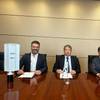Jan De Nul Orders Floating Installation Vessel
Luxembourg-based Jan De Nul has ordered a second mega offshore installation vessel, Les Alizés, from the CMHI Haimen shipyard in China.
Together with the Voltaire, the new floating installation crane vessel will be in a super-size class of its own, capable of building the newest generation of offshore wind farms.
Les Alizés, that will be ready in 2022, is equipped with a crane having a lifting capacity of 5,000 tons and equally impressive lifting heights.
Les Alizés will mainly be used for the construction of offshore wind farms, but with her impressive crane she is also extremely suitable for decommissioning offshore oil and gas platforms.
"Thanks to her dimensions and impressive lifting and loading capacities, Les Alizés will be able to load out, transport and install multiple units of the largest and heaviest wind turbine foundations. In addition, as a crane vessel that floats, it will be able to install heavier and larger foundations into deeper waters and in more challenging seabed conditions," said the company.
This vessel investment is a response to the global trend within the offshore wind energy sector to design and install increasingly larger wind turbines. This new generation of turbine can be more than 270 metres high, with blades up to 120 metres long and sit on foundations up to 2,500 tonnes.
The offshore installation vessels currently available on the market are experiencing great difficulties in installing these new turbines and their heavier foundations, with their enormous dimensions and installation weights.
Philippe Hutse, Offshore Director at Jan De Nul Group, explained: "We continue to invest in the future of offshore renewable energy. By ordering Les Alizés today, from 2022 we will have not one, but two, offshore installation vessels that will be able to install the newest generation of offshore wind farms. This is how we offer our customers the most efficient installation method."
Hutse added: "Similar to the Voltaire, we have financed this investment by means of a green loan thanks to the green emissions reduction technology on board the vessel. During the design phase, as is the case for all our new vessels, we studied very carefully the environmental impact and the solutions to minimize that impact."
Peter De Pooter, Manager Offshore Renewables at Jan De Nul Group said: "The order of the Voltaire was a first step in our strategy to install the newest generation of offshore wind turbines. With Les Alizés we want to further strengthen our vision and our belief in the future of offshore wind energy. We want to be a major and enduring player in this sector. For that reason, we continue to invest in the further expansion of our offshore renewables department."
The vessel will be built at a shipyard of China Merchants Industry Holdings Co. Ltd., located in Haimen, Nantong City, China. As a subsidiary of China Merchants Group, this shipyard has a proven track record in supplying marine and offshore facilities which gives Jan De Nul Group sufficient confidence to award this contract to CMIH.
Les Alizés is specifically designed for loading, transporting, lifting and installing offshore wind turbine foundations. The main features are a main crane of 5,000 tons, a deck loading capacity of 61,000 tons and a deck space of 9,300 m².
With these characteristics, Les Alizés can easily transport the heavier future foundations, several in one trip, to the offshore installation site, with direct benefits in planning, fuel consumption and emissions reduction.
Unlike the Voltaire, Les Alizés does not have four legs to lift itself above the sea surface. It is a crane vessel for floating installation, which means that the vessel is not dependent on the water depths and the seabed conditions. Les Alizés is equipped with a high-performance DP2 system.
When designing the vessel, Jan De Nul Group took into account the environmental impact. Jan De Nul tackles environmental challenges by focusing on reducing the footprint of its activities, particularly on water and air quality, and on the climate. Air pollution is one of the greatest threats to public health.
Construction activities at sea are usually located close to coastlines, large and small ports, and densely populated areas. The Group is aware that, regardless of the choice of fuel or engine technology, the exhaust gases must always be filtered.










